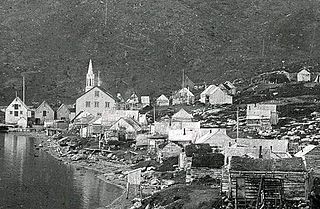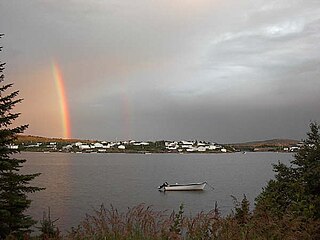
Soapstone is a talc-schist, which is a type of metamorphic rock. It is composed largely of the magnesium-rich mineral talc. It is produced by dynamothermal metamorphism and metasomatism, which occur in subduction zones, changing rocks by heat and pressure, with influx of fluids but without melting. It has been a carving medium for thousands of years.

The Beothuk were a group of Indigenous people of Canada who lived on the island of Newfoundland.

Ochre, iron ochre, or ocher in American English, is a natural clay earth pigment, a mixture of ferric oxide and varying amounts of clay and sand. It ranges in colour from yellow to deep orange or brown. It is also the name of the colours produced by this pigment, especially a light brownish-yellow. A variant of ochre containing a large amount of hematite, or dehydrated iron oxide, has a reddish tint known as red ochre.

Hebron was a Moravian mission and the northernmost settlement in Labrador. The traditional Nunatsiavummiutitut name for the area means "the Great Bay". Founded in 1831, the mission disbanded in 1959. The Inuk Abraham Ulrikab and his family, exhibited in human zoos in Europe in 1880, were from Hebron.

The Maritime Archaic is a North American cultural complex of the Late Archaic along the coast of Newfoundland, the Canadian Maritimes and northern New England. The Maritime Archaic began in approximately 7000 BC and lasted until approximately 3500 BC, corresponding with the arrival of the Paleo-Eskimo groups who may have outcompeted the Maritime Archaic for resources. The culture consisted of sea-mammal hunters in the subarctic who used wooden boats. Maritime Archaic sites have been found as far south as Maine and as far north as Labrador. Their settlements included longhouses, and boat-topped temporary or seasonal houses. They engaged in long-distance trade, as shown by white Ramah chert from northern Labrador being found as far south as Maine.
Jens Haven was a Danish Moravian missionary and the prime mover behind the founding of the Moravian missions in Labrador.
James A. Tuck, was an American-born archaeologist whose work as a faculty member of the Memorial University of Newfoundland was focused on the early history of Newfoundland and Labrador.

Okak is a former community located on Okak Bay in northern Labrador. It was founded in 1776 by Jens Haven, a missionary of the Moravian Church. In 1918, Moravian missionaries brought an outbreak of Spanish influenza that devastated Okak, killing 204 out of a population of 263.

Newfoundland and Labrador is the easternmost province in Canada. The Strait of Belle Isle separates the province into two geographical regions, Labrador and the island of Newfoundland. The province also includes over seven thousand small islands.

L'Anse-au-Loup (Town) is located on the banks of L'Anse-au-Loup Brook and the Strait of Belle Isle, in Newfoundland and Labrador province, Canada.

Killiniq is a former Inuit settlement, weather station, trading post, missionary post, fishing station, and Royal Canadian Mounted Police post on Killiniq Island. Previously within Labrador, and then the Northwest Territories, it is now situated within the borders of Nunavut. The community closed in 1978.
New Harbour is a local service district and designated place in the Canadian province of Newfoundland and Labrador. It is on the east shore of Trinity Bay, along Provincial Route 80. Route 80's intersection with Route 73 is inside New Harbour.

NunatuKavut is a proposed NunatuKavummiut territory in central and southern Labrador. The region proposed by the NunatuKavut Community Council (NCC) extends from north of the community of Makkovik in Nunatsiavut to south of the community of Blanc-Sablon in Quebec. It also extends to the west as far as the border between Quebec and Labrador. Previous submissions by the NunatuKavummiut included a secondary claim as far north as Nain, the northernmost community in Nunatsiavut.
Port au Choix is a peninsula on the western coast of the island of Newfoundland, Canada. Discoveries as early as 1904 provide evidence that native peoples settled here, burials, structural remains, and artifacts such as points, tools, and bones of discarded food.

William Wyvill Fitzhugh IV is an American archaeologist and anthropologist who directs the Smithsonian's Arctic Studies Center and is a Senior Scientist at the National Museum of Natural History. He has conducted archaeological research throughout the circumpolar region investigating cultural responses to climate and environmental change and European contact. He has published numerous books and more than 150 journal articles, and has produced large international exhibitions and popular films. Of particular note are the many exhibition catalogues he has had edited, which make syntheses of scholarly research on these subjects available to visitors to public exhibitions.
At the end of the last Ice Age, Newfoundland and Labrador were covered in thick ice sheets. The province has had a continuous human presence for approximately 5000 years. Although Paleo-Indians are known from Nova Scotia dating back 11,000 years, no sites have been found north of the St. Lawrence. The oldest traces of human activity, in the form of quartz and quartzite knives, were discovered in 1974 in southern Labrador, but some archaeologists have speculated that a human presence may go back as much as 9000 years. Highly acidic soils have destroyed much of the bone and other organic material left behind by early humans and thus complicates archaeological research.
Humans have inhabited Quebec for 11,000 years beginning with the de-glaciated areas of the St. Lawrence River valley and expanding into parts of the Canadian Shield after glaciers retreated 5,000 years ago. Quebec has almost universally acidic soils that destroy bone and many other traces of human activity, complicating archaeological research together with development in parts of southern Quebec. Archaeological research only began in earnest in the 1960s and large parts of the province remain poorly researched.
The geology of Newfoundland and Labrador includes basement rocks formed as part of the Grenville Province in the west and Labrador and the Avalonian microcontinent in the east. Extensive tectonic changes, metamorphism and volcanic activity have formed the region throughout Earth history.
The prehistory of New England is an important topic of research for New England archaeologists. Humans reached the current-day New England region by at least 10,500 years ago and likely earlier, occupying a recently de-glaciated environment. Pre-contact Native American groups in New England did not have full-fledged market economies and physical artifacts tended to change very slowly. However, technological shifts brought agriculture and ceramics to the region prior to the arrival of European settlers in the 17th century.

The Groswater culture was a Paleo-Eskimo culture that existed in Newfoundland and Labrador from 800 BC to 200 BC. The culture was of Arctic origin and migrated south after the decline of the Maritime Archaic people following the 900 BC Iron Age Cold Epoch. It is believed to have been replaced by or developed into the Dorset culture around 2000 BP. It is named after Groswater Bay, a bay in central Labrador.












